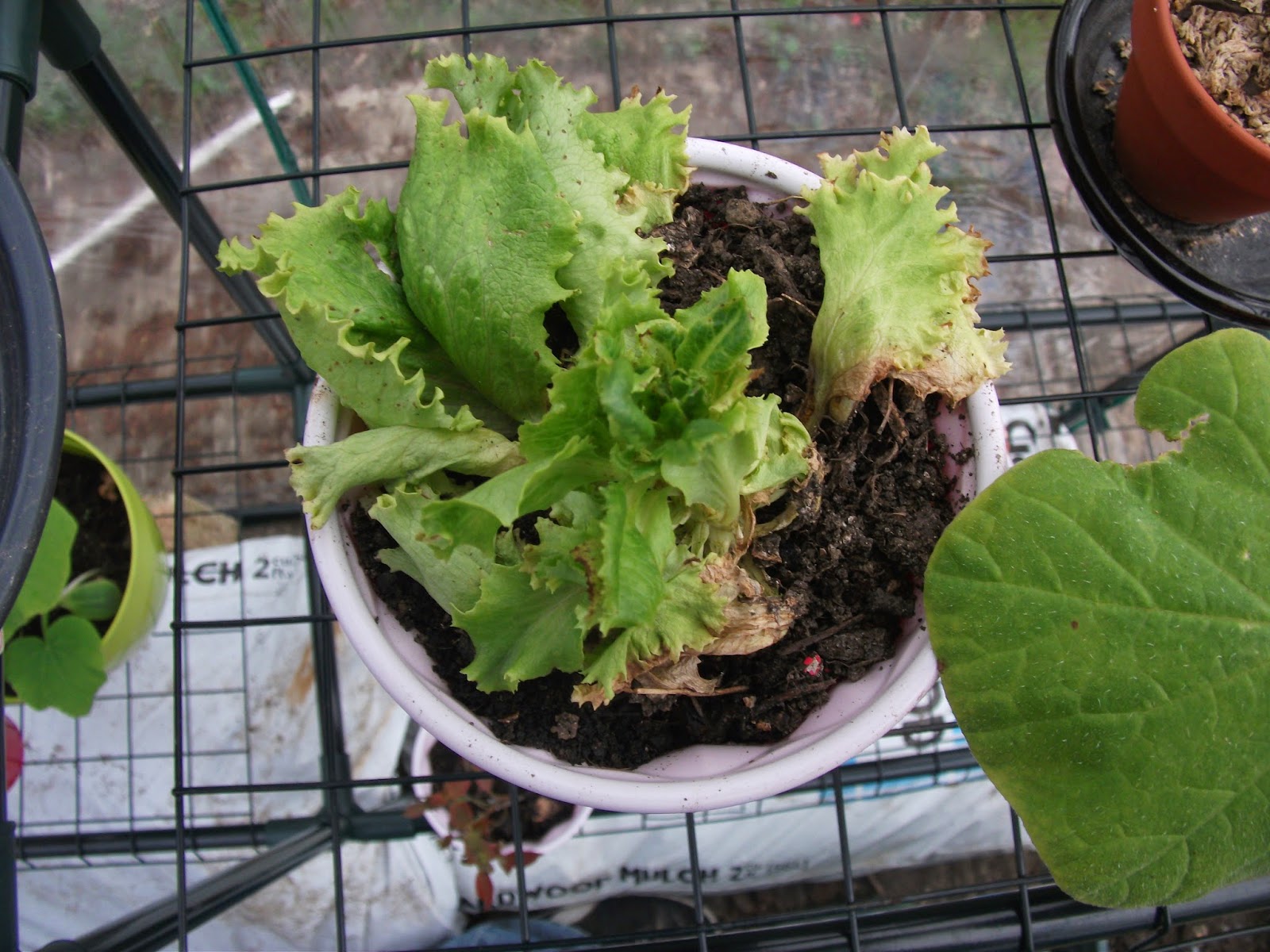Tadaa! Ok so there's nothing going on here. It's all dead leaves and grass for now, but hopefully in a few months it'll be packed with deliciousness! I've been out turning all the dead stuff trying to aerate it, and we just planted a few radishes today. I'm sure it's too early, but I've been itching to get some stuff going!
In other news
The greenhouse is still intact! I weighted it down with cement blocks and bags of mulch, which took out the bottom layer of shelving, but I figured the sacrifice was worth knowing that it wasn't going to blow away. And it's not like the bottom shelf is very useful anyway. Here are the pictures from inside the greenhouse:
Peas
These were a huge surprise to me. I had the seed for these for 3 years (I think, possibly longer) and didn't store them properly. I just thought I'd see what happened and planted 8 of them. 3 germinated, which I'm totally happy with. They were treated seeds, which I'm not really fond of, but I'm even less fond of wasting food. I'm going to direct sow more of them once I feel a little more confident with the weather.
Squash
I'm pretty happy with these little guys too. I planted these mid-March and they survived a greenhouse tip and took their transplanting like champs. I'm going to pland more of these too. This will be the first time I try to grow squash, and decided on butternut this year because we know that Karver likes it. We used some store bought ones for baby food last year, and hopefully we will have some fresh ones this year.
Onion

I've never tried onion from seed before either, so I thought I'd try it out. I'm not expecting much from these. I planted the first batch (in the round pot) the first part of February. They're hard to see in that picture, but there are 3 of them. The second batch was planted mid-March. They are staying alive, but don't seem to be growing at all. I realize that they are in containers, but I feel like they should be getting bigger too. Of course, it's possible that they are growing and I just can't tell. I hope.
Watermelon
Most of these didn't make it through the great greenhouse tip of '14. The few that did survive seem fairly healthy. I'm planning to start more of these this week and really hope they make it. I love watermelon!
Tomatoes
You can't go wrong with tomatoes right? Well, we'll see. I've grown seedlings before but this will be my first year from seed. They are still tiny. I'm kind of worried about these, but want to learn how to grow them from seed so I can start buying heirloom and saving seeds. I have a couple of varieties, but they got mixed together when everything got dumped. I have lots and lots and lots of these. I'm hoping they start growing once it warms up.
Peppers
I've got some bell, and some jalapenos. There are some tomatoes in the pictures too. These will be really interesting because they all got mixed together, so I may develop some new mutant peppers this year! I'm going to start more seeds soon so I can tell them apart too.
Lettuce
This is something else I don't have a lot of hope for. This is from some lettuce that I tried regrowing. It was doing great in the water, but when I put it in dirt it got all shrivelly and sucky. I'm hoping that it's just transplant shock and that it'll snap out of it. I may need to get it into a cooler place than the greenhouse during the day too.
Store bought stuff

Also from Meijer is this grapevine, which I thought I killed. Thankfully it bounced back (I'm going to attribute it to my homemade compost I planted it in.
...And raspberries
and say what you want about me, but I think the peach blooms are really pretty!
Strawberries! I'm planning on getting more too
I also have a couple of blueberry bushes from Burpee. They will bring my total to 5. I thought 1 got killed over the winter. I don't know if something nibbled on it or just ran past it and broke it off, but I saw one single little bud on it, so there's hope!
 I planted these black raspberries a few years ago from my parents' house. They alternate years, so this year should be the first year I get fruit from it. They also self rooted a ton of starts, so I cut them off from the parent plant, and may soon be overrun by them!
I planted these black raspberries a few years ago from my parents' house. They alternate years, so this year should be the first year I get fruit from it. They also self rooted a ton of starts, so I cut them off from the parent plant, and may soon be overrun by them!
These don't technically count as something I grew, but I'm planning on eating some dandelion for the first time this year. There are so many recipes I've been looking at. Does anyone have a favorite?
Flowers
 I assume these are a weed, but I kind of like them. I've seen them everywhere this year. Does anyone know what they are?
I assume these are a weed, but I kind of like them. I've seen them everywhere this year. Does anyone know what they are?
That's it so far! I've got a lot going on, and a lot more planned. If you have any advice for me, please feel free to leave comments below!!


















































